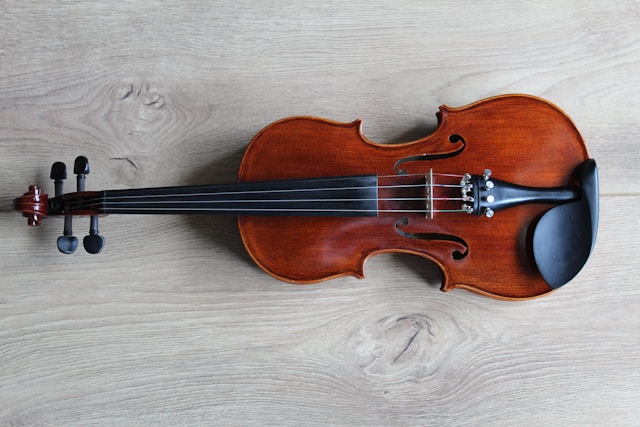Changing violin strings can be a daunting task for even experienced violinists. Over time, all violin strings can wear out, lose their tone, or break. It doesn’t matter if you are a beginner or professional, knowing how to change your violin strings is crucial to maintaining your instrument to the best of its ability. In this article, we’ll guide you through the step-by-step process of how to change your violin strings.
Understanding When to Change Violin Strings
Before diving into the specifics of how to change violin strings, it’s important to recognize when it’s time for a change.
Signs It’s Time for New Strings
- The strings have become discolored or unraveled.
- The sound quality has diminished, sounding dull or flat.
- The strings are more difficult to tune or don’t hold their tuning well.
- You notice a decrease in the responsiveness of the strings.
- Your strings sound out of tune when playing perfect intervals, like 5ths
How Often to Change Violin Strings
This can change depending on how much you play and what type of strings you use.
- Amateur players should consider changing their strings once a year.
- Intermediate players may need to change strings every 6 to 9 months.
- Professional players or those with heavy playing schedules might need to change strings every 3 to 4 months.
Preparing to Change Your Violin Strings
Before beginning, make sure you have the necessary items:
- A new set of violin strings.
- A clean, flat surface to work on.
- A violin peg compound or pencil (for lubricating the pegs and the bridge where the strings are placed)
Step-by-Step Guide to Changing Violin Strings
Changing strings one at a time is crucial to maintaining the tension on the bridge and keeping it in place. If you remove all your strings at once, you risk damaging your instrument.
Step 1: Removing the Old String
- Loosen the peg of the string you are changing until the string is completely slack.
- Unhook the string from the tailpiece and carefully remove it from the peg.
Step 2: Preparing the New String
- Uncoil the new string, being careful not to kink or bend it sharply.
- If your string has a ball end, ensure it’s secure. If it has a loop end, check that the loop is intact.
Step 3: Attaching the New String to the Tailpiece
- Hook the end of the string into the tailpiece’s notch or fine tuner, making sure it’s secure.
Step 4: Lubricating the Peg and Nut
- Apply a small amount of peg compound or draw on the grooves of the bridge with a soft pencil to lubricate them, which helps the string slide smoothly and prevents wear.
Step 5: Threading the String Through the Peg
- Insert the other end of the string through the hole in the peg.
- Wind the string onto the peg, starting from the hole and working towards the pegbox wall. The string should wind on the peg evenly and not overlap. You should wrap the string will wrap towards the side of the wood, making it fit snugly against the edge.
- Pro Tip: Make sure to wind the string away from you so the string goes over the peg, while this may seem insignificant, it helps the strings last longer and avoid your strings slipping.
Step 6: Tuning the New String
- Once the string is securely wound on the peg, begin to gently turn the peg, bringing the string up to pitch.
- Use a piano, tuning fork, or electronic tuner to assist with tuning.
- Be cautious not to over-tighten the string, as this could cause it to break.
- Pro Tip: Make sure to push the peg lightly into the instrument, securing it and helping avoid your string slipping. Additionally, guide the string with your other hand so that it wraps easily around the peg and doesn’t cross over itself.
Step 7: Tuning your new strings
- New strings often stretch, causing them to go out of tune quickly.
- Pro tip: Play loudly on your new strings to break them in. The first few days will try your patience with returning, but loud and consistent playing will help them break in quicker.
Step 8: Repeating the Process for Other Strings
- Follow the same steps for each string, one at a time, until all strings have been replaced.
- Pro Tip: Avoid mixing your old and new strings, it can easily become a messy undertaking if your not careful
Tips for String Maintenance
Proper care and maintenance can extend the life of your strings and keep them sounding their best.
Keep Your Strings Clean
- Wipe down your strings with a soft, dry cloth after playing to remove rosin build-up and oils from your fingers.
- Pro Tip: Alcohol wipes can be especially effective at cleaning the strings and making them feel and sound like new. Avoid getting any of the alcohol on your instrument, as this can lead to damage of the varnish. Additionally, allow your strings to dry before playing, you don’t want to get your mix it into your bow hair.
Humidity and Temperature
- Your strings will last longest if your instrument is kept in its case, in a temperature controlled room. Avoid extremes in both temperature and humidity, or else you may have to replace your strings more often than you’d like
Handling Strings Carefully
- Clean your hands before handling the strings as you don’t want to get any oil or sweat onto them. If you do, make sure to clean the string afterwards for best outcomes
Troubleshooting Common Issues
Slipping Pegs
- If the pegs are slipping, apply more peg compound or push the pegs in more firmly as you tune.
- Ensure the pegs are properly fitted to the peg holes.
Bridge Alignment
- Keep an eye on the bridge to ensure it remains straight and doesn’t tilt. It should be perpendicular to the top of the violin.
- If you are inexperienced with altering your bridge, don’t try to fix the issue as that can lead to your bridge collapsing and potentially damaging your instrument. Take your instrument to your nearest luthier, many will do it for free!
Conclusion
This guide should provide you with enough information so that you can confidently change your violin strings and maintain the sound of your instrument. Remember to change your strings regularly, keep them clean, and handle them with care to ensure the best possible outcome. With practice, changing strings will become a quick and easy part of your routine as a violinist. Good Luck!

